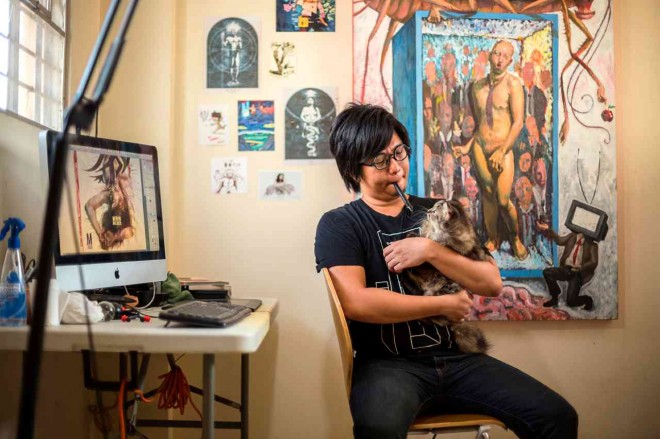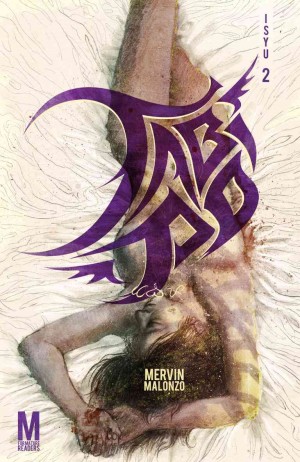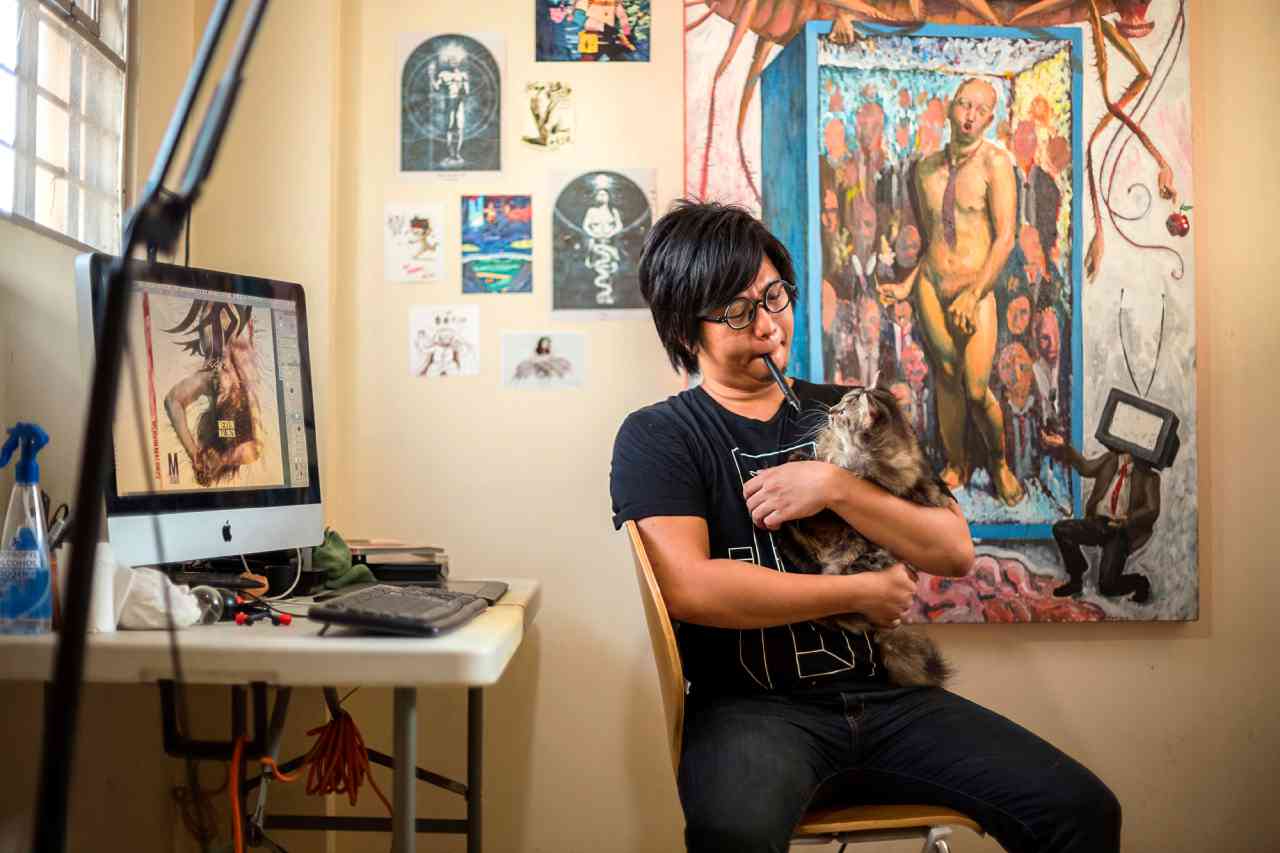
Imagine having a dream that has chased you since childhood: a four-color vision of panels and figures, of endless Fridays full of delight. Imagine wanting to do this more than anything.
If you were ever given the chance to do just that—but at the cost of everything else you know—what would you choose?
For comic book creator Mervin Malonzo, the choice was obvious. Last year, he opted to give up his thriving career in web design to work in comic books full-time. In particular, he devoted his time and talent to tend to his dazzling and daring webcomic, “Tabi Po,” shepherding the property to a best-selling print version and a future filled with the continuing choice of comic books above all else. It’s an epic story about an epic story.

The 29-year-old’s story is like a classic tale of the dreamer overcoming all obstacles strewn on his path by fate. Malonzo grew up in very humble surroundings in Ususan, Taguig, the eldest of five children born to watch repairman Felino and homemaker Eufronia.
Despite economic restraints, the boy grew into his artistic tendencies. “It wasn’t something you find out right away,” he recalls in Filipino. “But the earliest I can remember was that when I was 4 years old, I was already drawing stick figures on my mother’s cabinet. From the beginning, it was something I wanted to do, like it was my own language.”
Malonzo discovered the joy of comics through a time-honored Filipino tradition: reading Funny Komiks. He was about 7 at the time when his father brought home a copy of the seminal children’s comics title, giving him the chance to immerse himself in the adventures of “Combatron” and the antics of “Planet Op Di Eyps.” He was hooked.
“From there I started to learn how to read,” Malonzo remembers. “I thought I wanted to do something like this. It was my inspiration. Every Friday I would ask my father to get it for me. The other comics were in English but my family really didn’t speak it, so I couldn’t understand them.” He also read the children’s magazine Bata-batuta voraciously, and was influenced by the dubbed anime “Dragonball Z” on TV. Malonzo wouldn’t be exposed to American comics until he was already working.
After finishing high school at the Cavite State University (the family moved around a bit), Malonzo decided to take up a bachelor’s degree in Fine Arts, major in Painting, at the University of the Philippines in Diliman. The reason behind the choice? Comics, of course.
“There was no course for comics, so I majored in painting,” he explains. “I didn’t want to go to advertising because I felt I couldn’t relate it to comics.”
Malonzo graduated magna cum laude from UP and began working as a photo-restoration artist. “At the time, I didn’t know how to use Photoshop so that became my training,” he says. “After that, when I got bored from my job restoring photos, I researched how to make websites.” Through online tutorials, Malonzo taught himself web design, went freelance and discovered that clients liked his work.
“But there was a moment when I told myself, I didn’t like the work because I wasn’t happy,” Malonzo recalls. “It was like something was still missing. That was when I decided to make comics. Because I was doing web design, my direction was to do webcomics.”
When he visited the site of FreakAngels, a massive webcomic by the acclaimed writer Warren Ellis and artist Paul Duffield, he found something that suited his own needs and tastes. “I already had a story in my head, the epic that would become ‘Tabi Po.’ But then I realized that the webcomic didn’t have to be short pieces, that it could support long stories like those I had in my head,” he realized.
|
The story he had in his head, like his dream, was an artifact he had carried in his head for a while. Malonzo had relished reading Arnold Arre’s graphic novels, 1999’s “The Mythology Class” and 2006’s “Ang Mundo ni Andong Agimat.”
“I realized that Filipino mythology would be a good source for something unique,” Malonzo says. Eschewing an older plot for younger readers that had to do with ghosts, Malonzo chose an unusual protagonist: “I came up with a unique story with a perspective that usually belonged to the villains in the comics—the aswang (ghouls).” His aswang is a soulful one named Elias, a long-life creature that literally loved his food. It’s romantic and dangerous all at once.

“It’s like a deconstruction of our mythological creatures—not just the aswang, as we’ll see the later addition of other creatures,” he says. “He’s still an aswang—he still eats people—but you’d understand why he does the things he does. I want people to be attracted to that.”
Plucking a title from that phrase Filipinos utter when passing an anthill or an old tree so as not to attract the supernatural creatures’ ire, Malonzo launched “Tabi Po” (www.tabi-po.com) in 2010. The webcomic quickly attracted attention not only for its distinctive story, but Malonzo’s stunning art, sinewy pencil sketches augmented by digital colors to produce a striking watercolor effect. It looks like the panels are bleeding color.
“Tabi Po” quickly picked up a following. “I was somewhat surprised that I developed a fan following considering I started it just for myself,” he says. “I thought maybe they wouldn’t like it immediately because there was nudity and violence. But it turns out that’s what the people wanted.” Malonzo also drew inspiration from the comments of fellow comic creators whom he idolized, among them Budjette Tan and Gerry Alanguilan.
“Mervin is one of the most talented young Filipino comics creators I’ve seen. Seeing his work makes me feel ecstatic for the future of Philippine comics,” Alanguilan wrote online.
“Tabi Po” is obviously a labor of love, considering that Malonzo derived no income at all from the webcomic. He also had to constantly find time to create comics even as he was leading a web design group called Pepe & the Polygons. He got so busy with the business that he actually went through the entire 2012 without posting any new comic stories. Something had to be done.
With his mop top, thick eyeglass frames and goatee, the mellow Malonzo looks very much like a hippie who has joined a Beatles tribute band. But he’s an all-art-all-the-time dude. After a stint with TV5, Malonzo pledged to pay off his group’s debts. Once that was done, he did the unthinkable: He quit his day job.
“I really missed working on ‘Tabi Po,’” he says. “I was able to save some money from a TV5 stint so there were months where I worked only on comics. Once that was gone, I had to get freelance work from my network of clients,” he says. He now considers himself a full-time comic book creator and a part-time web designer.
His readers welcomed the arrival of his new webcomic stories. “The fans were still there when I got back,” he says. He also took “Tabi Po” to the next step. After working with Flipside (https://flipside.ph) to release an e-book version (the e-book is in English, the original webcomic is in Filipino), Malonzo approached publisher Visprint Inc. through the intercession of “Trese” writer Tan, to do a print version, something he had always dreamed of.
“It was the first modern local comics in that style. It was very violent and graphic, pero ang sarap niyang tignan (but it was good to look at),” explains Visprint’s Nida Ramirez. “And while there weren’t that many words or text, each frame manages to effectively convey the movement and progression of the story.” The first collection, “Tabi Po: Isyu 1” was released at the Summer Komikon and sold very well, some 300 copies in a day, says Ramirez. For Malonzo, the sales are like a muttered wish come true.
He has yet to receive royalties from Visprint’s print version, but he is optimistic since the book has already gone into a second printing. He estimates he needs a few more months before he can really sustain the full-time comics creation. He needs at least P30,000 a month to support his parents and send his siblings to school. “But I’m happy I manage to survive.”
Malonzo explains that the first print volume has about 60 percent of the webcomic story thus far, but the second volume, “Tabi Po: Isyu 2,” due out in November’s anticipated Komikon, will complete the story and contains new material.
Malonzo has also become a much sought-after comic book artist. When the comic book studio Studio Salimbal (www.salimbalcomics.com) launched earlier this year, the studio featured six projects, all of them to be illustrated by Malonzo. These projects range widely in theme and topic, and are written by Carljoe Javier, Eliza Victoria, both bemedalled writers, and Noel Pascual, a similarly hardworking talent with whom Malonzo has four projects.
Studio Salimbal’s model is to release the material online first before it hopefully appears in print. In line with Studio Salimbal’s goals, Malonzo is working to finish all the art before the titles are released in 2015. “I just really like collaborating with other people,” Malonzo says. “Whenever there’s a concept, I change my style to suit it. I want to do the projects well because people have expectations now.”

Studio Salimbal mastermind Paolo Chikiamco has this to say about Malonzo’s versatility and production: “To my knowledge, all of these projects came about specifically to allow for a collaboration between a particular artist and Mervin. Mervin’s work—not just in comics but in general illustration and design—has been diverse and distinct enough that many writers can visualize their stories and concepts through the lens of Mervin’s art.”
Outside of Studio Salimbal and “Tabi Po,” Malonzo is working on the graphic novel series “Ang Subersibo—Isang Adaptasyon ng mga Nobelang ‘Noli Me Tangere’ at ‘El Filibusterismo’” with writer Adam David for Adarna House’s Anino comics imprint. He has an unnamed project with a media company that he hopes will be both successful and lucrative. “We think it will be a game-changer,” he says coyly.
All the work comes from Malonzo’s studio apartment in Parañaque, a townhouse he shared with his married best friend, a designer. Malonzo’s apartment is spartan, with corners crammed full of books (a lot of Alan Moore, a manga collection by Osamu Tezuka, some Haruki Murakami novels and several Philippine graphic novels), some Tanduay Ice empties hidden under a desk and ambient music in the air. There are fast food delivery menus taped to one wall and some college-era Malonzo paintings on other walls. There’s a treadmill that Malonzo bought so he could lose weight. The dominant feature of the apartment are the seven Persian cats who have the run of the place. That’s par for the course in the world according to Mervin.
Malonzo may be the only Filipino comic book creator who has managed to live on full time work doing Philippine comic book projects. “I want to be able to sustain doing just comics forever,” he says sanguinely. “But I don’t know… I have received job offers that are so tempting, with six-figure offers that I wouldn’t be able to get from comics. But if I want to have a house or a home, I’d have to work again.”
The money remains the big concern. “It’s a struggle because there is something you really want to do but can’t, because you need money,” he says. He still accepts commissions for drawing and painting but says that if he really needed cash, he would paint, host an exhibit and sell paintings.
The prize, however, is already in his grasp—comics 24/7—and he is loathe to ever let go.
Says Chikiamco: “The future’s bright for Mervin—not only is he a versatile artist with a distinctive style and a strong aesthetic, but he’s also got the intangibles that will allow him not only to be a good artist, but also a productive and marketable one. For someone who wants to do comics full time, more than pure talent is needed. You need to be able to operate as a businessman, manage your time, promote your work, engage your audience, protect your rights—on your own or in a group. Mervin is on the ball even with regard to non-creative aspects. Not everyone is—which is one of the reasons why I see grouping and consolidation as a necessary step to artistic sustainability here.”
Beyond the agony and ecstasy that come with creating his comic stories, Malonzo has another very ambitious goal. “I want to contribute to the history of comic books in the Philippines. When people look back at the history of comics here, they will see my work as having been involved in that development. What I’m thinking about isn’t the money, but the work, to be able to do my own ‘Watchmen,’ something that big.”
Here then is the epic story coming close to its denouement, the dreamer approaching glory, the hero almost completing his journey, with the shores of his imagined destination now in sight.
“‘Tabi Po’ is my masterpiece for now,” Mervin Malonzo concludes. “And that’s because I haven’t thought of anything better yet.” •









































